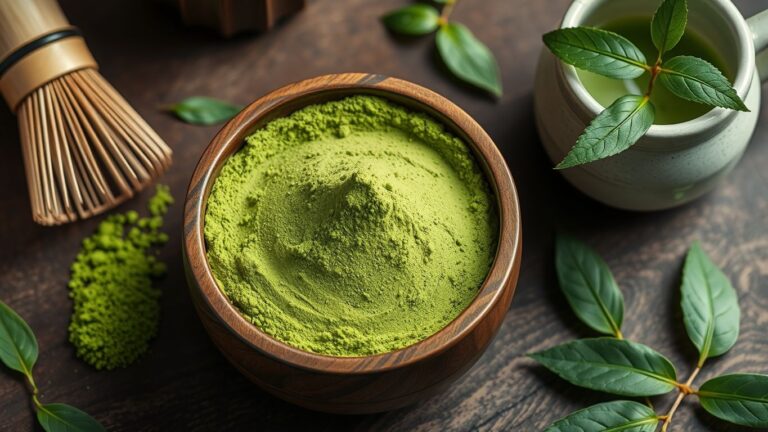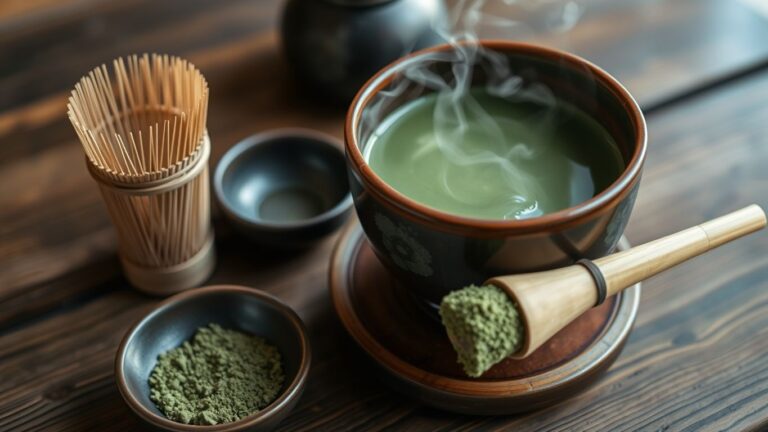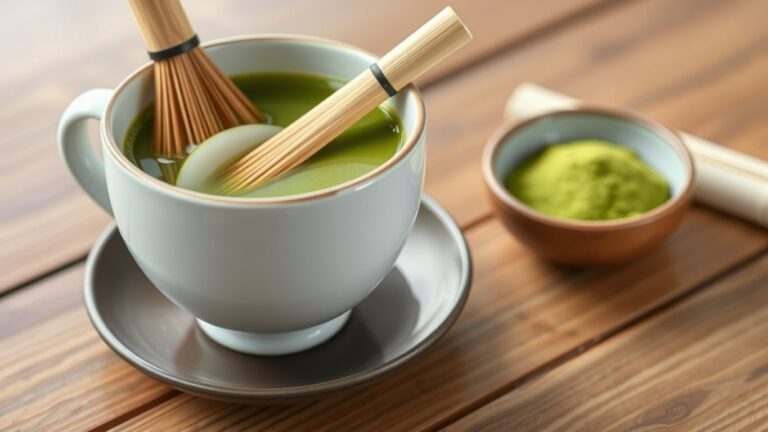Matcha lattes are a trendy alternative to traditional coffee drinks, known for their vibrant green color and unique taste. This delightful beverage is made using matcha powder, which is finely ground green tea leaves, mixed with milk and sometimes sweeteners. For those mindful of their calorie intake, understanding the caloric content of a matcha latte is essential. This article breaks down the calories in various matcha latte preparations, the factors that influence these calories, and tips for making a lower-calorie version.
Key Takeaways
- Matcha lattes are made from matcha powder, milk, and sometimes sweeteners.
- The type of milk and sweeteners used can significantly affect the calorie content.
- Unsweetened matcha lattes with almond milk are the lowest in calories.
- Matcha lattes offer health benefits like antioxidants and improved brain function.
- Choosing low-calorie milk and reducing sweeteners can help lower the calorie count.
Understanding the Basics of a Matcha Latte
What is Matcha?
Matcha is a type of green tea made from finely ground tea leaves. Unlike regular green tea, where you steep the leaves and then discard them, with matcha, you consume the entire leaf. This means you get more nutrients and antioxidants. Matcha is known for its vibrant green color and earthy flavor.
Traditional Preparation Methods
Traditionally, matcha is prepared using a bamboo whisk called a chasen. The matcha powder is sifted into a bowl, hot water is added, and then it’s whisked until frothy. This method ensures a smooth and creamy texture. In Japan, this preparation is often part of a tea ceremony, emphasizing mindfulness and appreciation.
Common Ingredients in a Matcha Latte
A matcha latte typically includes the following ingredients:
- Matcha powder
- Hot water
- Milk (dairy or plant-based)
- Sweeteners (optional)
The type of milk and sweeteners you choose can significantly affect the taste and caloric content of your latte. For a lower-calorie option, you might opt for almond milk and skip the sweeteners.
This hot beverage with green tea powder is packed with antioxidants and tastes better than Starbucks. It’s simple to make at home and easy to customize with your favorite ingredients.
Caloric Content of Different Matcha Latte Variations
When it comes to matcha lattes, the number of calories can vary widely based on the ingredients and preparation methods. Here, we’ll explore the caloric content of different matcha latte variations to help you make informed choices.
Unsweetened Matcha Latte with Skim Milk
An unsweetened matcha latte made with skim milk typically contains around 85-95 calories. This is a great option if you’re looking to enjoy a matcha latte without too many added calories.
Matcha Latte with Almond Milk
If you prefer almond milk, an unsweetened matcha latte can have roughly 35-65 calories. Almond milk is a popular choice for those seeking a lower-calorie alternative to dairy milk.
Matcha Latte with Whole Milk and Sugar
A matcha latte made with whole milk and sugar can be upwards of 200 calories or more, depending on the amount of sugar added. This variation is richer and sweeter but comes with a higher calorie count.
Remember, these values are approximate and can vary based on the specific ingredients and preparation methods used by different cafes and brands.
Factors Influencing the Caloric Content of a Matcha Latte

When it comes to the calorie content of a matcha latte, several factors come into play. Understanding these can help you make healthier choices and enjoy your drink without the extra calories.
Type of Milk Used
The type of milk you choose can significantly impact the calorie count. For example:
| Milk Type | Calories per Cup (240 ml) |
|---|---|
| Whole Milk | 150 |
| Skim Milk | 80-90 |
| Almond Milk | 30-60 |
| Soy Milk | 80-110 |
| Oat Milk | 120-170 |
Amount and Type of Sweeteners
Sweeteners can add a lot of calories to your matcha latte. A tablespoon of sugar adds about 49 calories, while flavored syrups can add anywhere from 50 to 100 calories or more per serving. Reducing or eliminating sweeteners can make a big difference.
Serving Size and Add-Ins
The size of your drink and any additional ingredients also affect the calorie content. Larger servings naturally contain more calories. Add-ins like flavored syrups, whipped cream, or other toppings can further increase the calorie count.
The calorie content of a matcha latte largely depends on two factors: the quantity of matcha powder used and the type of milk. A basic beverage involves these elements, but add-ins and sweeteners can quickly add up.
By being mindful of these factors, you can enjoy a delicious matcha latte that fits your dietary needs.
Comparing Matcha Lattes to Other Popular Beverages
Matcha Latte vs. Sugary Sodas
When you compare an unsweetened matcha latte to a sugary soda, the difference in calories is quite clear. A typical sugary soda can have 150-200 calories per 12-ounce serving. In contrast, an unsweetened matcha latte usually has significantly fewer calories, making it a healthier choice.
Matcha Latte vs. Blended Coffee Drinks
Blended coffee drinks are often loaded with calories, sometimes exceeding 300-400 calories per serving. An unsweetened matcha latte is a much lower-calorie option. The high-quality matcha used in homemade lattes offers more caffeine and l-theanine compared to the blends used by Starbucks and Dunkin’.
Matcha Latte vs. Plain Tea
Plain tea is one of the lowest-calorie beverages you can choose, with around 2-5 calories per cup. While an unsweetened matcha latte has more calories, it also provides additional health benefits from the matcha, such as antioxidants and nutrients.
Health Benefits of Matcha
Rich in Antioxidants
Matcha is packed with antioxidants, especially catechins. These powerful compounds help protect your cells from damage. Catechins, an antioxidant in matcha, may help reduce the risk of chronic diseases.
Boosts Brain Function
Drinking matcha can enhance your brain function. Studies show that it can improve attention, reaction time, and memory. Imagine being more focused and alert just by sipping on your favorite latte!
Promotes Heart Health
Matcha may help keep your heart healthy. It has been shown to lower bad cholesterol and triglycerides. Combined with a balanced diet and exercise, matcha can be a great addition to your heart health routine.
Drinking matcha regularly can be a simple way to support your overall well-being.
Tips for Making a Lower-Calorie Matcha Latte

Choosing Low-Calorie Milk Alternatives
One of the easiest ways to cut calories in your matcha latte is by choosing a low-calorie milk alternative. Options like almond milk, skim milk, or oat milk can significantly reduce the overall calorie count. For instance, almond milk typically has fewer calories compared to whole milk.
Reducing or Eliminating Sweeteners
Sweeteners can add a lot of extra calories to your matcha latte. Consider reducing the amount of sugar or using natural sweeteners like stevia. If you can, try to enjoy your matcha latte unsweetened to keep the calorie count low.
Opting for Smaller Serving Sizes
The size of your matcha latte can also impact its calorie content. A larger serving size will naturally have more calories. When ordering at a coffee shop, consider choosing a smaller size to keep your calorie intake in check.
Making small changes like choosing low-calorie milk alternatives and reducing sweeteners can make a big difference in the calorie content of your matcha latte.
Matcha Latte Nutrition Facts
Caloric Breakdown
Understanding the caloric content of a matcha latte can help you make informed choices. A typical small matcha latte with milk contains around 317 calories. Here’s a breakdown of where those calories come from:
- Carbohydrates: 64% (approximately 51g)
- Fats: 15% (around 5g)
- Protein: 21% (about 17g)
Macronutrient Composition
The macronutrient composition of a matcha latte varies based on the ingredients used. For a small matcha latte with milk, you can expect the following:
- Total Fat: 5g (7% of Daily Value)
- Saturated Fat: 5g (24% of Daily Value)
- Trans Fat: 0g
- Cholesterol: 6mg (2% of Daily Value)
- Sodium: 420mg (18% of Daily Value)
- Total Carbohydrates: 51g (19% of Daily Value)
- Dietary Fiber: 0g (0% of Daily Value)
- Sugars: 46g
- Protein: 17g
Vitamins and Minerals
Matcha lattes also provide a variety of vitamins and minerals, although the exact amounts can vary. Here are some common nutrients found in a matcha latte:
- Calcium: Important for bone health
- Iron: Essential for blood production
- Potassium: Helps regulate fluid balance
- Vitamin A: Supports vision and immune function
- Vitamin C: Important for skin health and immune function
Keep in mind that the nutritional content can vary based on the type of milk and sweeteners used. Always check the specific product labels for the most accurate information.
Popular Matcha Latte Recipes
Classic Matcha Latte Recipe
Hi everyone! I’ve been enjoying matcha lattes lately and wanted to share my recipe with you all. It’s a perfect balance of creamy and earthy flavors, and it’s super easy to make at home.
Ingredients:
- 1 teaspoon matcha powder
- 2 ounces hot water
- 1 cup milk (your choice of type)
- Sweetener to taste (optional)
Instructions:
- Sift the matcha powder into a bowl to remove any clumps.
- Add the hot water and whisk until the matcha is fully dissolved and frothy.
- Heat the milk until steaming, then froth it using a frother or whisk.
- Pour the matcha mixture into a cup, then add the frothed milk.
- Sweeten to taste if desired and enjoy!
Iced Matcha Latte Recipe
For a refreshing twist, try an iced matcha latte. It’s perfect for warm days and just as delicious as the hot version.
Ingredients:
- 1 teaspoon matcha powder
- 2 ounces hot water
- 1 cup cold milk (your choice of type)
- Ice cubes
- Sweetener to taste (optional)
Instructions:
- Sift the matcha powder into a bowl to remove any clumps.
- Add the hot water and whisk until the matcha is fully dissolved and frothy.
- Fill a glass with ice cubes.
- Pour the matcha mixture over the ice.
- Add the cold milk and stir well.
- Sweeten to taste if desired and enjoy!
Vegan Matcha Latte Recipe
If you’re looking for a dairy-free option, this vegan matcha latte is a great choice. It’s creamy, delicious, and completely plant-based.
Ingredients:
- 1 teaspoon matcha powder
- 2 ounces hot water
- 1 cup almond milk (or any plant-based milk)
- Sweetener to taste (optional)
Instructions:
- Sift the matcha powder into a bowl to remove any clumps.
- Add the hot water and whisk until the matcha is fully dissolved and frothy.
- Heat the almond milk until steaming, then froth it using a frother or whisk.
- Pour the matcha mixture into a cup, then add the frothed almond milk.
- Sweeten to taste if desired and enjoy!
Making matcha lattes at home allows you to control the ingredients and customize the flavor to your liking. Whether you prefer it hot or iced, with dairy or plant-based milk, there’s a matcha latte recipe for everyone.
Frequently Asked Questions About Matcha Lattes

Is Matcha Latte Good for Weight Loss?
Yes, a matcha latte can be a good choice for weight loss, especially if you opt for low-calorie milk alternatives and avoid adding too much sugar. Matcha stands out as an exceptional energy booster due to its unique combination of natural caffeine and l-theanine, which can help you stay active and burn more calories.
Can You Drink Matcha Latte Every Day?
Absolutely! Drinking a matcha latte every day is generally safe and can be part of a healthy diet. However, it’s important to be mindful of the added sugars and calories, especially if you have multiple servings.
What Are the Best Milk Alternatives for Matcha Lattes?
There are several great milk alternatives for matcha lattes, including:
- Almond milk: Low in calories and has a mild flavor.
- Soy milk: A good source of protein and has a creamy texture.
- Oat milk: Slightly sweet and creamy, but higher in calories.
Each of these options can help you enjoy a delicious matcha latte while keeping the calorie count low.
Exploring Matcha Latte Add-Ins and Toppings

Adding a little extra to your matcha latte can make it even more delightful. Here are some popular add-ins and toppings to consider:
Flavored Syrups
Flavored syrups can transform your matcha latte into a symphony of fun flavors. Cinnamon, vanilla, and caramel are popular choices. However, keep in mind that these syrups can add extra calories and sugar to your drink.
Whipped Cream
Whipped cream is a decadent topping that adds a creamy texture to your matcha latte. While it makes your drink richer, it also increases the calorie count. A dollop of whipped cream can add around 50-100 calories.
Healthy Toppings
For a healthier twist, consider adding toppings like chia seeds, matcha powder, or a sprinkle of cocoa. These options not only enhance the flavor but also add nutritional benefits.
Experimenting with different add-ins and toppings can make your matcha latte experience more enjoyable and personalized.
Conclusion
In summary, matcha lattes are a delightful and nutritious alternative to traditional coffee drinks. The calorie content can vary widely depending on the type of milk and sweeteners used. An unsweetened matcha latte with almond milk can be as low as 35 calories, while one with whole milk and sugar can exceed 200 calories. By making mindful choices, such as opting for low-calorie milk alternatives and limiting sweeteners, you can enjoy this vibrant green beverage without worrying too much about the calories. So, next time you’re at a café or making one at home, you’ll know exactly how to keep your matcha latte both delicious and healthy.
Frequently Asked Questions
Is a matcha latte good for weight loss?
Yes, a matcha latte can be good for weight loss, especially if you choose low-calorie milk and avoid added sugars. Matcha is low in calories and can boost metabolism.
Can you drink a matcha latte every day?
Yes, you can drink a matcha latte every day. Matcha is rich in antioxidants and has various health benefits. Just be mindful of the calories if you add sweeteners or high-fat milk.
What are the best milk alternatives for matcha lattes?
Some great milk alternatives for matcha lattes include almond milk, oat milk, and coconut milk. These options are often lower in calories and can add a unique flavor.
How many calories are in a matcha latte with almond milk?
A matcha latte with almond milk typically has around 35-65 calories, depending on whether the almond milk is sweetened or unsweetened.
Does matcha have caffeine?
Yes, matcha contains caffeine. However, it usually provides a more gradual energy boost compared to coffee, thanks to the presence of L-theanine.
Is matcha latte healthier than coffee?
Matcha lattes can be healthier than coffee because they contain antioxidants and provide a steady energy boost without the jitters. However, the health benefits depend on the ingredients used.
What is the difference between ceremonial-grade and culinary-grade matcha?
Ceremonial-grade matcha is made from the youngest tea leaves and is used for traditional tea ceremonies. Culinary-grade matcha is slightly more bitter and is used in cooking and baking.
Can I make a matcha latte without sweeteners?
Yes, you can make a matcha latte without sweeteners. The natural flavor of matcha is slightly earthy and bitter, and many people enjoy it without any added sugar.






